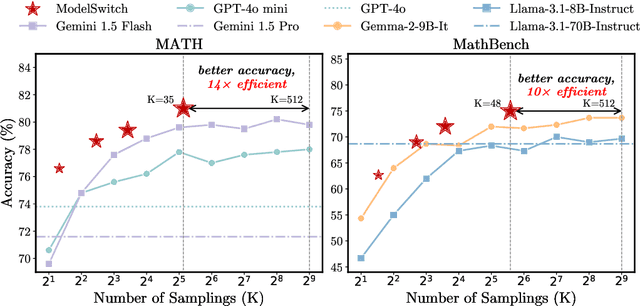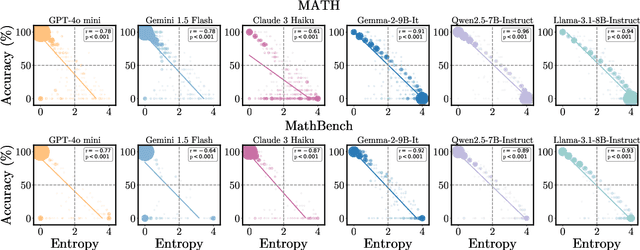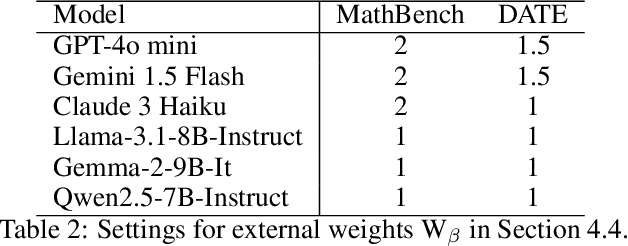Qiaosheng Zhang
PerPilot: Personalizing VLM-based Mobile Agents via Memory and Exploration
Aug 25, 2025Abstract:Vision language model (VLM)-based mobile agents show great potential for assisting users in performing instruction-driven tasks. However, these agents typically struggle with personalized instructions -- those containing ambiguous, user-specific context -- a challenge that has been largely overlooked in previous research. In this paper, we define personalized instructions and introduce PerInstruct, a novel human-annotated dataset covering diverse personalized instructions across various mobile scenarios. Furthermore, given the limited personalization capabilities of existing mobile agents, we propose PerPilot, a plug-and-play framework powered by large language models (LLMs) that enables mobile agents to autonomously perceive, understand, and execute personalized user instructions. PerPilot identifies personalized elements and autonomously completes instructions via two complementary approaches: memory-based retrieval and reasoning-based exploration. Experimental results demonstrate that PerPilot effectively handles personalized tasks with minimal user intervention and progressively improves its performance with continued use, underscoring the importance of personalization-aware reasoning for next-generation mobile agents. The dataset and code are available at: https://github.com/xinwang-nwpu/PerPilot
SafeWork-R1: Coevolving Safety and Intelligence under the AI-45$^{\circ}$ Law
Jul 24, 2025Abstract:We introduce SafeWork-R1, a cutting-edge multimodal reasoning model that demonstrates the coevolution of capabilities and safety. It is developed by our proposed SafeLadder framework, which incorporates large-scale, progressive, safety-oriented reinforcement learning post-training, supported by a suite of multi-principled verifiers. Unlike previous alignment methods such as RLHF that simply learn human preferences, SafeLadder enables SafeWork-R1 to develop intrinsic safety reasoning and self-reflection abilities, giving rise to safety `aha' moments. Notably, SafeWork-R1 achieves an average improvement of $46.54\%$ over its base model Qwen2.5-VL-72B on safety-related benchmarks without compromising general capabilities, and delivers state-of-the-art safety performance compared to leading proprietary models such as GPT-4.1 and Claude Opus 4. To further bolster its reliability, we implement two distinct inference-time intervention methods and a deliberative search mechanism, enforcing step-level verification. Finally, we further develop SafeWork-R1-InternVL3-78B, SafeWork-R1-DeepSeek-70B, and SafeWork-R1-Qwen2.5VL-7B. All resulting models demonstrate that safety and capability can co-evolve synergistically, highlighting the generalizability of our framework in building robust, reliable, and trustworthy general-purpose AI.
Unsupervised Skill Discovery through Skill Regions Differentiation
Jun 17, 2025Abstract:Unsupervised Reinforcement Learning (RL) aims to discover diverse behaviors that can accelerate the learning of downstream tasks. Previous methods typically focus on entropy-based exploration or empowerment-driven skill learning. However, entropy-based exploration struggles in large-scale state spaces (e.g., images), and empowerment-based methods with Mutual Information (MI) estimations have limitations in state exploration. To address these challenges, we propose a novel skill discovery objective that maximizes the deviation of the state density of one skill from the explored regions of other skills, encouraging inter-skill state diversity similar to the initial MI objective. For state-density estimation, we construct a novel conditional autoencoder with soft modularization for different skill policies in high-dimensional space. Meanwhile, to incentivize intra-skill exploration, we formulate an intrinsic reward based on the learned autoencoder that resembles count-based exploration in a compact latent space. Through extensive experiments in challenging state and image-based tasks, we find our method learns meaningful skills and achieves superior performance in various downstream tasks.
The Avengers: A Simple Recipe for Uniting Smaller Language Models to Challenge Proprietary Giants
May 26, 2025Abstract:As proprietary giants increasingly dominate the race for ever-larger language models, a pressing question arises for the open-source community: can smaller models remain competitive across a broad range of tasks? In this paper, we present the Avengers--a simple recipe that effectively leverages the collective intelligence of open-source, smaller language models. Our framework is built upon four lightweight operations: (i) embedding: encode queries using a text embedding model; (ii) clustering: group queries based on their semantic similarity; (iii) scoring: scores each model's performance within each cluster; and (iv) voting: improve outputs via repeated sampling and voting. At inference time, each query is embedded and assigned to its nearest cluster. The top-performing model(s) within that cluster are selected to generate the response using the Self-Consistency or its multi-model variant. Remarkably, with 10 open-source models (~7B parameters each), the Avengers collectively outperforms GPT-4.1 on 10 out of 15 datasets (spanning mathematics, code, logic, knowledge, and affective tasks). In particular, it surpasses GPT-4.1 on mathematics tasks by 18.21% and on code tasks by 7.46%. Furthermore, the Avengers delivers superior out-of-distribution generalization, and remains robust across various embedding models, clustering algorithms, ensemble strategies, and values of its sole parameter--the number of clusters. We have open-sourced the code on GitHub: https://github.com/ZhangYiqun018/Avengers
MM-PRM: Enhancing Multimodal Mathematical Reasoning with Scalable Step-Level Supervision
May 19, 2025Abstract:While Multimodal Large Language Models (MLLMs) have achieved impressive progress in vision-language understanding, they still struggle with complex multi-step reasoning, often producing logically inconsistent or partially correct solutions. A key limitation lies in the lack of fine-grained supervision over intermediate reasoning steps. To address this, we propose MM-PRM, a process reward model trained within a fully automated, scalable framework. We first build MM-Policy, a strong multimodal model trained on diverse mathematical reasoning data. Then, we construct MM-K12, a curated dataset of 10,000 multimodal math problems with verifiable answers, which serves as seed data. Leveraging a Monte Carlo Tree Search (MCTS)-based pipeline, we generate over 700k step-level annotations without human labeling. The resulting PRM is used to score candidate reasoning paths in the Best-of-N inference setup and achieves significant improvements across both in-domain (MM-K12 test set) and out-of-domain (OlympiadBench, MathVista, etc.) benchmarks. Further analysis confirms the effectiveness of soft labels, smaller learning rates, and path diversity in optimizing PRM performance. MM-PRM demonstrates that process supervision is a powerful tool for enhancing the logical robustness of multimodal reasoning systems. We release all our codes and data at https://github.com/ModalMinds/MM-PRM.
CPGD: Toward Stable Rule-based Reinforcement Learning for Language Models
May 18, 2025Abstract:Recent advances in rule-based reinforcement learning (RL) have significantly improved the reasoning capability of language models (LMs) with rule-based rewards. However, existing RL methods -- such as GRPO, REINFORCE++, and RLOO -- often suffer from training instability, where large policy updates and improper clipping can lead to training collapse. To address this issue, we propose Clipped Policy Gradient Optimization with Policy Drift (CPGD), a novel algorithm designed to stabilize policy learning in LMs. CPGD introduces a policy drift constraint based on KL divergence to dynamically regularize policy updates, and leverages a clip mechanism on the logarithm of the ratio to prevent excessive policy updates. We provide theoretical justification for CPGD and demonstrate through empirical analysis that it mitigates the instability observed in prior approaches. Furthermore, we show that CPGD significantly improves performance while maintaining training stability. Our implementation balances theoretical rigor with practical usability, offering a robust alternative for RL in the post-training of LMs. We release our code at https://github.com/ModalMinds/MM-EUREKA.
Do We Truly Need So Many Samples? Multi-LLM Repeated Sampling Efficiently Scales Test-Time Compute
Apr 02, 2025



Abstract:This paper presents a simple, effective, and cost-efficient strategy to improve LLM performance by scaling test-time compute. Our strategy builds upon the repeated-sampling-then-voting framework, with a novel twist: incorporating multiple models, even weaker ones, to leverage their complementary strengths that potentially arise from diverse training data and paradigms. By using consistency as a signal, our strategy dynamically switches between models. Theoretical analysis highlights the efficiency and performance advantages of our strategy. Extensive experiments on six datasets demonstrate that our strategy not only outperforms self-consistency and state-of-the-art multi-agent debate approaches, but also significantly reduces inference costs. Additionally, ModelSwitch requires only a few comparable LLMs to achieve optimal performance and can be extended with verification methods, demonstrating the potential of leveraging multiple LLMs in the generation-verification paradigm.
MM-Eureka: Exploring Visual Aha Moment with Rule-based Large-scale Reinforcement Learning
Mar 10, 2025Abstract:We present MM-Eureka, a multimodal reasoning model that successfully extends large-scale rule-based reinforcement learning (RL) to multimodal reasoning. While rule-based RL has shown remarkable success in improving LLMs' reasoning abilities in text domains, its application to multimodal settings has remained challenging. Our work reproduces key characteristics of text-based RL systems like DeepSeek-R1 in the multimodal space, including steady increases in accuracy reward and response length, and the emergence of reflection behaviors. We demonstrate that both instruction-tuned and pre-trained models can develop strong multimodal reasoning capabilities through rule-based RL without supervised fine-tuning, showing superior data efficiency compared to alternative approaches. We open-source our complete pipeline to foster further research in this area. We release all our codes, models, data, etc. at https://github.com/ModalMinds/MM-EUREKA
If Multi-Agent Debate is the Answer, What is the Question?
Feb 12, 2025Abstract:Multi-agent debate (MAD) has emerged as a promising approach to enhance the factual accuracy and reasoning quality of large language models (LLMs) by engaging multiple agents in iterative discussions during inference. Despite its potential, we argue that current MAD research suffers from critical shortcomings in evaluation practices, including limited dataset overlap and inconsistent baselines, raising significant concerns about generalizability. Correspondingly, this paper presents a systematic evaluation of five representative MAD methods across nine benchmarks using four foundational models. Surprisingly, our findings reveal that MAD methods fail to reliably outperform simple single-agent baselines such as Chain-of-Thought and Self-Consistency, even when consuming additional inference-time computation. From our analysis, we found that model heterogeneity can significantly improve MAD frameworks. We propose Heter-MAD enabling a single LLM agent to access the output from heterogeneous foundation models, which boosts the performance of current MAD frameworks. Finally, we outline potential directions for advancing MAD, aiming to spark a broader conversation and inspire future work in this area.
Graph Feedback Bandits on Similar Arms: With and Without Graph Structures
Jan 24, 2025Abstract:In this paper, we study the stochastic multi-armed bandit problem with graph feedback. Motivated by applications in clinical trials and recommendation systems, we assume that two arms are connected if and only if they are similar (i.e., their means are close to each other). We establish a regret lower bound for this problem under the novel feedback structure and introduce two upper confidence bound (UCB)-based algorithms: Double-UCB, which has problem-independent regret upper bounds, and Conservative-UCB, which has problem-dependent upper bounds. Leveraging the similarity structure, we also explore a scenario where the number of arms increases over time (referred to as the \emph{ballooning setting}). Practical applications of this scenario include Q\&A platforms (e.g., Reddit, Stack Overflow, Quora) and product reviews on platforms like Amazon and Flipkart, where answers (or reviews) continuously appear, and the goal is to display the best ones at the top. We extend these two UCB-based algorithms to the ballooning setting. Under mild assumptions, we provide regret upper bounds for both algorithms and discuss their sub-linearity. Furthermore, we propose a new version of the corresponding algorithms that do not rely on prior knowledge of the graph's structural information and provide regret upper bounds. Finally, we conduct experiments to validate the theoretical results.
 Add to Chrome
Add to Chrome Add to Firefox
Add to Firefox Add to Edge
Add to Edge